TechnologyMarch 22, 2024
Factory automation showcase: Industrial Ethernet innovations

Industry experts agree that the foundation of Industrial Ethernet solutions for factory automation remains laser-focused on smart connected machines, edge and cloud-based computing, the potential impact of AI technology and new products and tools that simplify the ongoing quest for IT-OT integration.
INDUSTRIAL ETHERNET FACTORY AUTOMATION SOLUTIONS represent critical, foundational technology that provide a communications backbone for smart connected machines, improved convergence of IT-OT functions, cybersecurity and new capabilities based on industrial edge and cloud-based architectures.
For this Factory Automation solutions update, the Industrial Ethernet Book reached out to industry experts to gain their perspectives on how technology is continuing to move ahead with a range of effective innovations targeting factory automation.
Smart connected machines
Improving production flexibility to adapt quickly to changing market demands.
According to Vivek Bhargava, Product Marketing Manager at Cisco Industrial IoT, “the key factory automation trend that we see is the rise of connected factories with smart connected machines. Manufacturers are investing in technology that would help them in making data-driven business decisions, countering cybersecurity threats, increasing sustainability, and improving production flexibility to adapt quickly to changing market demands.

Cisco Industrial Ethernet switches feature the best of industrial and enterprise characteristics.
“Being a foundational technology for Industry 4.0 and providing the communications backbone for interconnected devices, Industrial Ethernet is critical to realizing these objectives. Continuing innovation in industrial switching is helping build a scalable, flexible, and resilient network for uninterrupted operations minimizing unplanned downtime and allowing faster adjustments to the product mix,” Bhargava said.
Bhargava said that modern Industrial Ethernet powered industrial networks share architectural elements with their enterprise counterparts, which enables closer partnership between OT and IT teams to help bring IT practices to rapidly expanding OT networks.
Today’s Industrial Ethernet unifies OT security with the network which helps manufacturers simplify network design and eliminate single function “point” products. Further advances in Industrial Ethernet enable manufacturers to collect, transform, and transmit process data to analytical applications in the cloud for actionable insights. Sustainability innovations in Industrial Ethernet such as modular designs, high MTBF, and industrial PoE help reduce and reuse of components and energy.
Importance of Industrial Ethernet
In the next 3-5 years, as manufacturers continue to invest in smart production initiatives, Bhargava said that Industrial Ethernet with higher performance, edge compute, built-in security, easy installation, configuration, and troubleshooting, will play a key role in determining the success of such initiatives.
“Gigabit or even 10Gbps high-speed ports and high switching capacity enables real-time monitoring and communications for applications like machine vision, robotics, and AI analytics,” Bhargava said.
Edge compute within Industrial Ethernet allows applications to run directly on network equipment and avoid separate dedicated appliances. It is ideally suited for running advanced cyber security features such as visibility into OT assets and zero-trust network access (ZTNA) gateways, or collect and transmit process data, etc. Running advanced features as software applications embedded in Industrial Ethernet makes the overall architecture simpler, more scalable, and more secure.
Multi-level granular segmentation capabilities within Industrial Ethernet allows ISA/IEC 62443 based creation of zones and conduits to help limit effects of security breaches.
“An ecosystem of supporting management and security applications allows for easy installation, configuration, redeployment, and monitoring to ensure performance, making the industrial network scalable and flexible,” Bhargava said.
“Modular designs, and innovations in industrial power-over-ethernet (PoE) technology help manufacturers extend the life of existing equipment and have a better control over power consumption.”

Cisco Industrial Ethernet host OT security functions eliminating the need for separate servers.
Future enhancements
Bhargava said that advances in Industrial Ethernet will help unlock Industry 4.0 benefits with a secure, adaptable foundation which will help simplify deployments, strengthen security, and enable scalable cloud connectivity. Moreover, Industrial Ethernet innovations can make industries more sustainable through resource optimization and reduce environmental impact throughout the product lifecycle.
“By replacing discrete hardware resources with software running in central virtual machines, Control Systems virtualization is certainly one of the most innovative applications that a modern Industrial Ethernet network can enable. Such virtualization can make operations even more agile and scalable, increase security, improve disaster recovery, and reduce costs,” he said.
He added that industrial networks can also benefit with edge-compute capabilities in modern Industrial Ethernet, that can host visibility, segmentation, and remote access applications unifying OT security with networking. Such a converged architecture reduces complexity, making it easier to scale operations, and allows engineering teams to focus on product and process innovation rather than the network itself.
Digital transformation
Bhargava said that Industrial Ethernet remains a key enabler of digital transformation and IIoT. Industrial Ethernet provides a stable and secure foundation for connecting machines, devices, and sensors, enabling real-time data exchange and communication crucial for data-driven decision-making. High-performance Ethernet solutions support the high bandwidth and low latency requirements of advanced applications like machine learning, predictive maintenance, and remote monitoring, key components of IIoT and Industry 4.0.
Edge computing capabilities within Industrial Ethernet allow visibility and security applications to run within the network without additional appliances and can also enable real-time data analysis and decision-making closer to the source. Seamless integration of Industrial Ethernet with IT systems allows for enterprise-wide data visibility, centralized management, and improved collaboration between OT and IT teams.
“Overall, Industrial Ethernet is not just a foundation for digital transformation but an active driver of innovation and progress. By focusing on advanced integration, edge computing, convergence, and robust security, Industrial Ethernet can unlock even greater potential for IIoT and enterprise connectivity, paving the way for a smarter, more efficient, and secure industrial future,” he said.
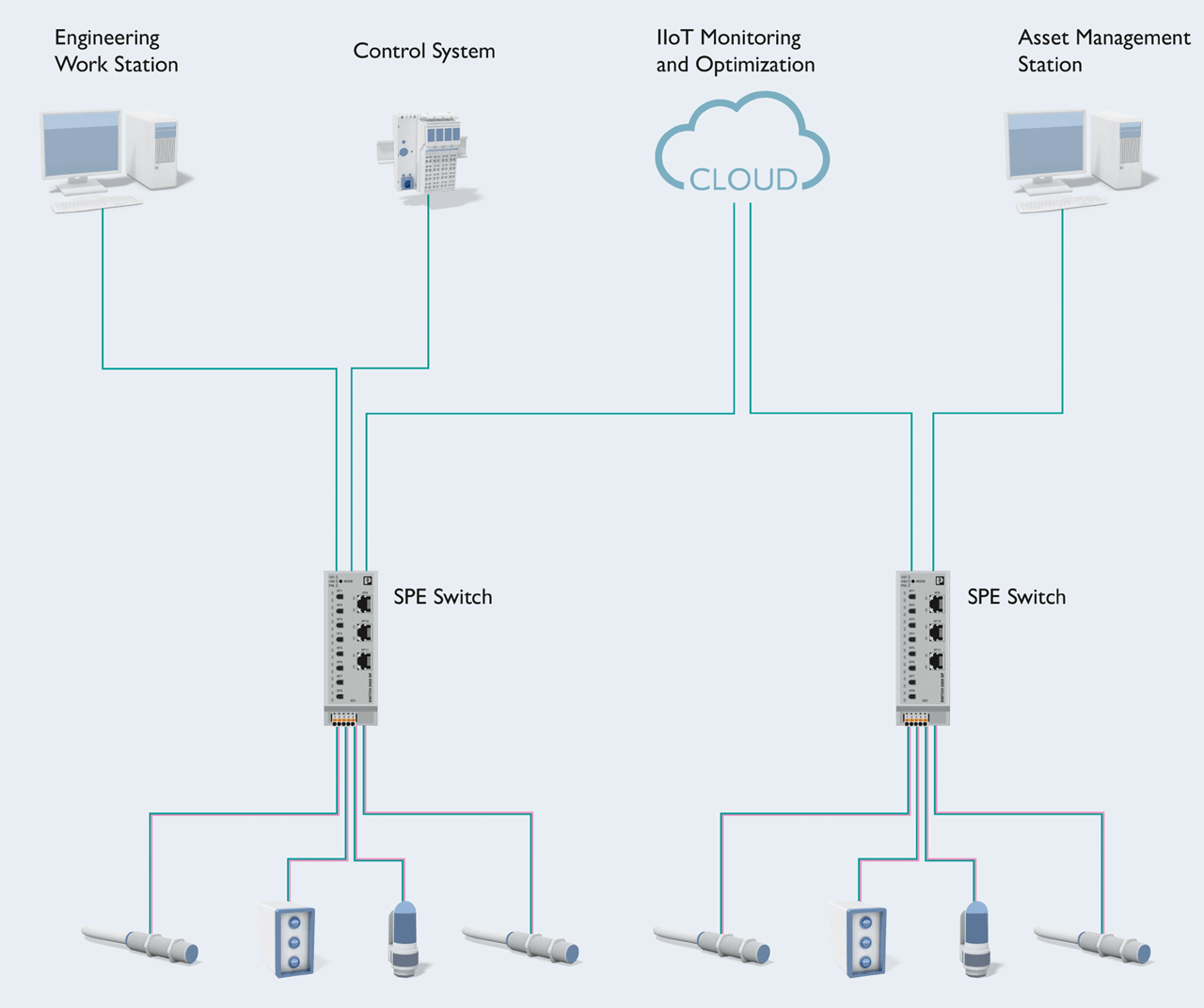
Uniform Ethernet-based communication from the sensor to the cloud.
Leveraging cloud data
End-to-end communication between controls, sensors and actuators, plus vertical communication with higher-level MES or ERP systems.
Frank Schewe, Deputy Vice President Automation Infrastructure at Phoenix Contact told IEB that, these days, with the help of connected sensors and actuators, factory automation applications are able to collect a wide range of data from the field in cloud-based systems, making it available for more in-depth analysis.
“Machine learning and artificial intelligence can be used to derive information, for example, for optimizing technical processes and to enable a proactive approach to maintaining technical systems. State-of-the-art industrial Ethernet networks make it possible to establish the necessary end-to-end communication between control systems and the connected sensors and actuators, and also vertical communication between the technical process and higher-level MES or ERP systems,” Schewe said.
He added that, with the bandwidth available in these networks, data from the field can be stored and processed in cloud-based systems. One important prerequisite for any subsequent analysis and evaluation of the large amounts of data generated in this way is a precise time stamp that enables correlations to be recognized and derived. In addition to the system operator, the data can also be used by system suppliers and manufacturers to offer value-added services such as customer service and quality enhancements, for example.
Another prerequisite for many pay-per-use business models is the availability of process data in the cloud. Instead of investing in a technical system or an asset, manufacturers offer these business models as an added service that is billed by use.
Technology innovations
“The focus in the past was on extending data rates and different transmission media while further developing Ethernet as part of the IEEE 802 project, but important innovations are now being developed in the data link layer (DLL) and higher layers, i.e., above the physical layer and media access control (MAC) layer,” Schewe said.
Over the past few years, the IEEE 802.1 working group has created and published a host of new Ethernet standards under the umbrella term, Time Sensitive Networks (TSN).
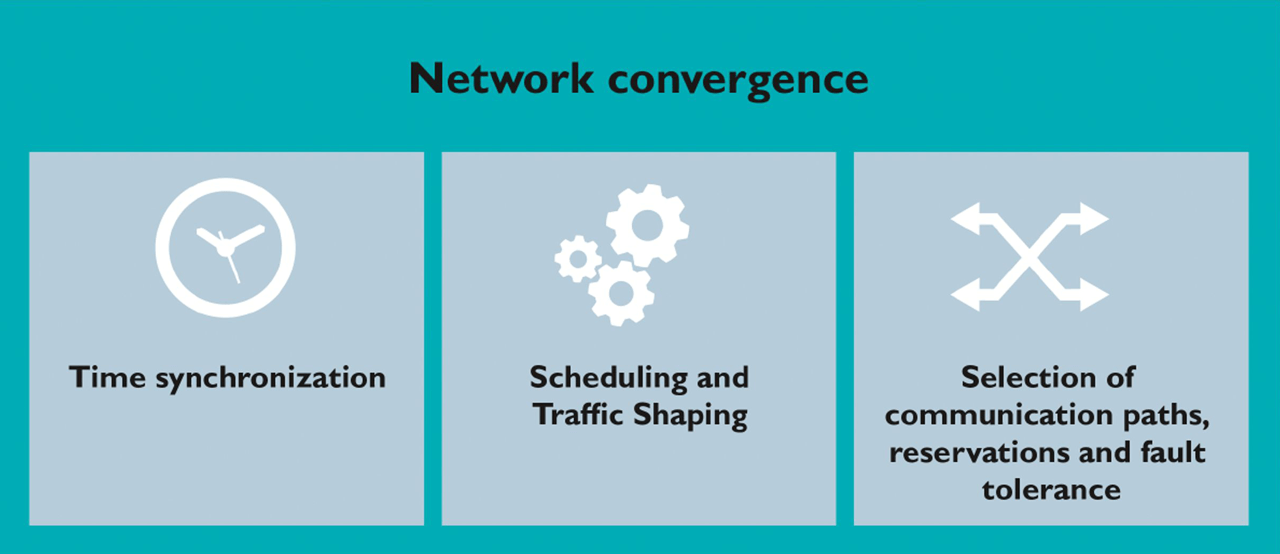
TSN components enable network convergence.
The TSN components created as a result can be assigned to the following thematic groups:
- Latency (e.g., frame preemption, scheduled traffic, and traffic shaping)
- Availability (e.g., frame replication and elimination, path control, and reservation)
- Synchronization (timing and synchronization)
- API and resource management (e.g., stream reservation protocol, YANG models)
Combined, the TSN tools enable a guaranteed and short latency time (deterministic) in the transmission of high-priority data between a transmitter and one or more receivers. Data packets can be duplicated and sent via different routes in the network to ensure the seamless compensation of any equipment or transmission link failures. Where possible, the network recognizes and eliminates duplicates before delivery to the recipient. The 802.1AS standard describes the synchronization of distributed clocks, creating the prerequisite for the planned transmission of data in high-priority data streams.
A profile for industrial automation is currently being specified as part of the IEC/IEEE 60802 project which describes how these standards are to be applied in detail, so that even the most demanding industrial applications can be operated in convergent networks.
Industrial Ethernet technology
Schewe said that the Single Pair Ethernet (SPE) transmission physics developed by IEEE 802.3 provides data rates of 10 Mbps to 1 Gbps via a single two-wire line. This reduces installation costs and enables the direct connection of even very small sensors and actuators to the industrial Ethernet network with a range of up to 1,000 meters. Power can be transmitted to wherever supply voltage is required, to a sensor for example, via Power over Data Line (PoDL) in different performance classes using the same wire pair. SPE technology also enables the development of easy-to-handle connectors that can be assembled in the field, offering many advantages for the user in contrast to the RJ-45 connectors used so far. This means that small and compact end devices with direct Ethernet connectivity can now be realized with SPE.
“The biggest advantage of Single Pair Ethernet technology, however, lies in the end-to-end, IP-based networking from the sensor via connectors to the cloud. Until recently, applications of this kind were implemented using special gateways, requiring complex configuration. This end-to-end approach creates the basis for cross-manufacturer asset management and enables value-added services such as patch and device management down to the smallest sensor,” he said.
IIoT and enterprise connectivity
Schewe said that the key concepts of Industry 4.0 are based on simple and consistent networking at all levels of the automation pyramid and TCP/IP-based data exchange. Industrial Ethernet systems have been making a triumphant advance over a number of decades from the top of the pyramid right down to the field level. As a result, classic traditional fieldbus systems for communicating between the controller and end devices have now been replaced by Ethernet-based industrial communication systems. With this approach, TSN creates the prerequisites for deterministic Industrial Ethernet communication and SPE technology enables the connection of simple sensors and actuators.

Reduced cabling effort due to reduction to only one wire pair.
He added that there are two things that are still required, however, for realizing Industry 4.0 solutions in the context of the digital transformation with IIoT devices: first of all, unique and tamper-proof device identities that manufacturers apply to the devices during the production of the device instances.
“These verifiable device identities enable secure connections to be established to the assets. Second of all, IIoT devices must have standardized data models (administration shells), enabling a much easier and efficient implementation of cross-manufacturer functions such as asset and configuration management. Concepts such as the digital twin of a device or system, which can be extended to include data regarding the use of the asset during its life cycle, cannot be realized in any other way,” Schewe said.
Focus on Edge Computing
Processing data near where it’s collected, at the edge of the network.
“In the realm of factory automation, a notable megatrend is the focus on edge computing, which is about processing data near where it’s collected, at the edge of the network. This approach is crucial for linking factory operations with cloud-based systems, where further analysis and storage can happen,” Dan White, Director of Technical Marketing at Opto 22 told the Industrial Ethernet Book recently.
But White said that understanding and setting up these cloud connections is essential before fully utilizing them.
“It’s important to ensure that edge devices are securely connected to the cloud, which involves proper setup and security measures. Look for devices that are “zero trust”, meaning that no one is permitted access to any resources unless explicitly granted. This careful approach prevents unauthorized data access and ensures that only secure, meaningful data exchanges occur between the factory floor and cloud services,” he said.
Industrial Ethernet technologies
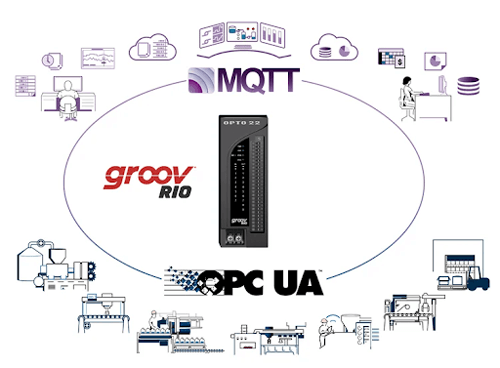
MQTT OPC UA ecosystem
White said that MQTT with Sparkplug B, OPC UA, and RESTful APIs will be pivotal in the evolution of Industrial Ethernet technologies.
“All of these technologies rely upon TCP/IP—the standard for network communication and winner of the protocol wars—for their foundation. MQTT, known for its lightweight and efficient messaging protocol, especially when combined with Sparkplug B, facilitates outbound originated communication between devices and applications,” White said.
OPC UA stands out for reliable interoperability in industrial automation, enabling diverse systems to speak a common language. APIs—RESTful being the most popular one—which have been widely utilized in the IT sector, will continue to grow their footprints and play a crucial role in facilitating flexible and accessible integration between different software components.
“The unique appeal of Industrial Ethernet lies not in its distinctiveness but in its universality and compatibility with widespread commercial technology. By leveraging the same Ethernet used across various IT applications, from online banking to social media, Industrial Ethernet ensures seamless integration with existing networks,” White said.
He added that this approach eliminates the need for proprietary protocols, emphasizing the importance of standardization and interoperability in industrial settings. The key advantage here is the ability to adopt secure, reliable, and high-speed communication technologies that are already proven in the broader IT world, making it easier for industrial systems to connect, communicate, and scale within the modern digital landscape.
“Industrial Ethernet solutions are pivotal in the digital transformation journey, embracing openness by supporting any protocol that operates over the TCP/IP stack,” White said. “This inclusivity extends to legacy proprietary Ethernet protocols like ProfiNET, Modbus/TCP, and EtherNet/IP as well as to newer, open protocols like OPC UA and MQTT Sparkplug B. Industrial Ethernet covers the gamut from traditional wired connections to wireless technologies like WiFi, cellular networks, satellite communications, and even emerging systems like Starlink. This flexibility means that Industrial Ethernet can adapt to diverse industrial needs and IIoT integration.”
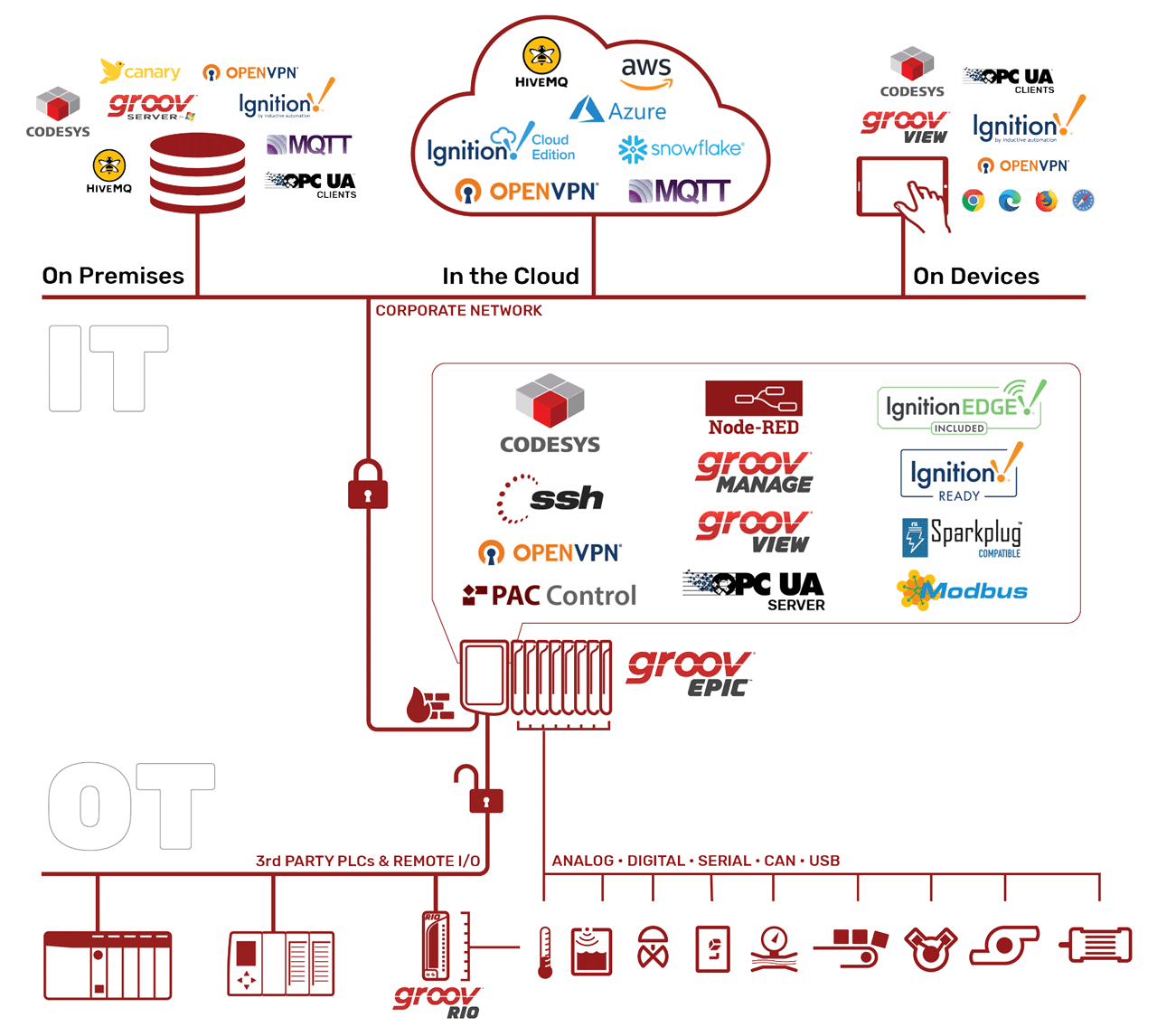
EPIC System Diagram
Artificial Intelligence (AI)
Large language models and custom AI models set to make an impact on manufacturing.
“The expectations are extremely high for the potential improvements that Artificial Intelligence (AI) can make in productivity across industries for good reason. Large language models are already proving out to be very effective as translation tools and custom AI models are allowing for control of sophisticated food manufacturing equipment that was only previously possible with highly experienced operators,” Dr. Al Beydoun, ODVA President and Executive Director told IEB.
Beydoun did say, however, that it will take time for AI to be fitted, improved and rolled out cost effectively across all of the different organizational areas where it can add the most value.
One of the hurdles that AI will need to overcome to optimize production in automation facilities will be the transfer of device level data back and forth to the cloud securely.
“Security has been growing in importance over time as ransomware attacks have proven to be profitable. The growing number of breaches that have affected consumers via large retail credit card exposures along with sabotage at power and wastewater facilities have led governments to develop security regulations with additional laws currently under consideration,” Beydoun said.
Looking ahead
Beydoun said that utilizing control networks that support data models that include semantics, context, and consistent measurement scales is another way to accelerate the deployment of AI. Otherwise, significant resources can be needed to clean the data to get it ready for use. Data preparation can both slow projects and even make them economically unviable. Also, information models are a very practical and low-cost solution that will enable end users to utilize their existing control networks to connect their valuable automation data to the cloud for analysis and optimization. That’s why EtherNet/IP supports the Process Automation Device Information Model (PA-DIM) for process and OPC UA for other industries.
“The thing that is unique about AI is that it is a dynamic tool in the same way that people are. AI is typically comprised of multidimensional mathematical models that utilize probability and repeated trials to predict accurate results. In the same way that people will answer the same question in different ways at different times, an AI model will do the same,” Beydoun said.
He added that AI can handle a high level of real-world complexity because the models are built with many different levels and types of mathematical algorithms to be able to recognize different trends and potential optimizations in the same data set. AI models can be revised to increase or decrease the number of processing layers depending on the task. While the current cost of AI is higher than that of simple search algorithms, the potential value of being able to help people to do their jobs better is also much higher. AI has the potential to optimize production cycle times, reduce energy usage, improve quality, and more in industrial automation. The challenge will be to take the time to properly implement custom AI models for the specific needs of the business.
Impact on digital transformation
“Technology has been an enabler of prosperity over the past century, allowing for an increased standard of living for billions of people globally. AI promises to be the next stage in technology development that will allow for increased worker productivity leading to enhanced output and wages,” Beydoun said.
“Furthermore, AI can help us to minimize waste in automation to help drive sustainability forward in a cost-effective manner. It’s critical that security is built into the foundation of industrial control networks now to ensure that the progress that AI can allow for isn’t derailed. Automation solutions such as CIP Security for EtherNet/IP offer benefits such as device-level firewalls as a part of a defense in depth security approach. The future of digital transformation is one of self-sustaining, exponential improvement that is enabled by AI. Workers can only do so much on their own and it looks like technology is ready to help them take the next step forward. Industrial Ethernet networks that are built on a solid foundation of security and allow data to be transported to the cloud and back via data models will be the future of IIoT automation.”
Enabling IT-OT integration
Switches integrate IT standards and provide factory automation users ease of use features.
Mike Willett, Network Engineer at Red Lion Controls highlighted key industry megatrends and how Industrial Ethernet solutions are evolving to provide continuing innovation in factory automation applications.
“The biggest trend is the ability to provide a product that can integrate within the standards of an IT department while giving users on the factory automation side the ease of use to take complete control of their application,” Willett said.
For example, N-Tron series NT5000 switches provide a user-friendly graphical interface that has ease of use functionality. However, the NT5000 also has the features the IT department requires. All the necessary aspects from both sides are available. In most cases the factory automation network must integrate within the IT infrastructure. So, this makes that connection far more efficient to build and maintain a complete solution. Speaking of the requirement to integrate with an IT department, another big trend is the addition of more advanced security features. The NT5000 switch has added more advanced security features within a platform that again caters to both controls engineers and the more IT centric user.
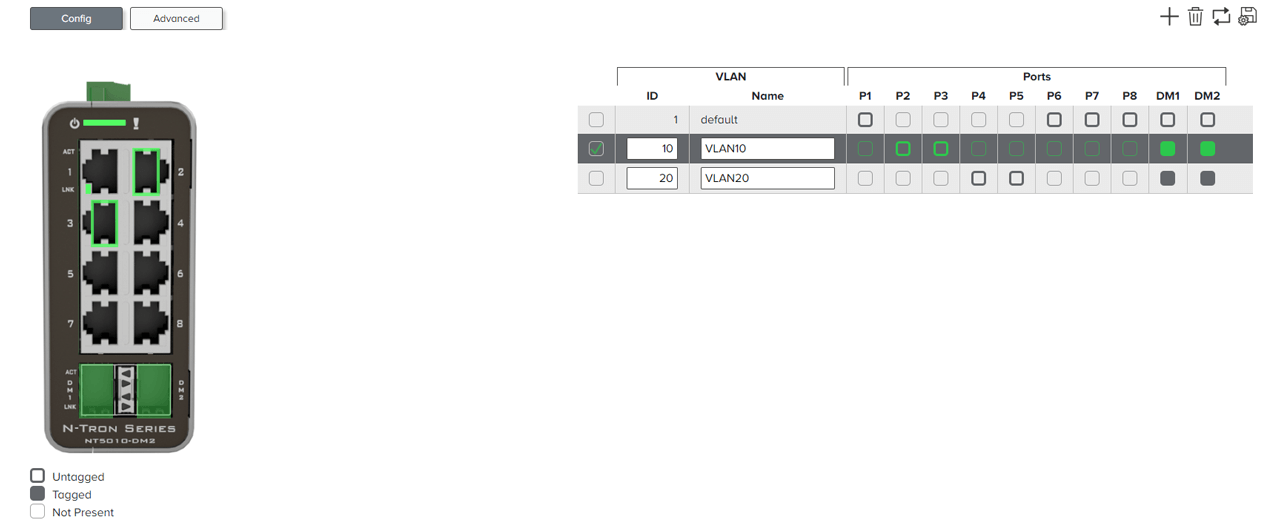
N-Tron series NT5000 switches provide a user-friendly graphical interface and ease of use functionality.
Industrial Ethernet technologies
Willett added that the use of high-speed fiber for internetwork communications and even copper connections will continue to be a huge necessity.
“The use of gigabit on every port and not just your uplink connections will continue to be important as more and more devices are added into the network and require the use of higher bandwidth. Also, VLANs have always been a great way to segment local network traffic and minimize congestion. The use of features like this to make the network more efficient is a huge benefit,” Willett said.
The new NT5000 switch from Red Lion was specifically designed to support the ease of use to deploy features just like this. In the web interface of the NT5000 switch there is an interactive visual under the VLAN section that displays what VLANs are associated to what ports and what the port states of the VLANs are.
A graphical representation of the VLANs is a tool to visualize this concept, especially if the user is not a networking expert. Instead of just having a check box for a tagged VLAN, for example, this visual can give the user a much more intuitive view of the VLAN implementation. It helps to take a potentially confusing topic and break it down into something more visual, so it is much easier to see, understand and ultimately to configure properly.
One last thing to mention is the use of diagnostics on site. Diagnostics is extremely valuable to gain insight into the network to make troubleshooting easier and to constantly monitor the network. The NT5000 switch from Red Lion has great diagnostics tools as well.
“New enhancements will make using Industrial Ethernet Technology unique because the ease of use will be there and the learning curve for users that are not network experts will be less,” Willett added.
The NT5000 switch from Red Lion was designed specifically with that ease of use. This is going to allow users and administrators of the industrial network to have greater control over the network and also build the network more efficiently as the complication of implementing the proper features drops. So, now with less complication the network can have proper security measures, proper segmentation methods and proper methods to easily diagnose and troubleshoot potential issues. Also, with the “IT Like” command line interface and the ability to also be administered by an IT individual as well, this makes the integration between IT and OT much more efficient.
Transformational technology
“As more and more devices need to be seen remotely or within a cloud environment the transformation of Industrial Ethernet will certainly provide more insight into user data as well as the network infrastructure itself,” Willett said. “Having insight into the network devices as well as the relevant data is extremely important. With the use of managed switches users will be able to gather more diagnostic and monitoring information from the switches themselves to help passively monitor the network and also be able to gain more insight into the network remotely before even having to travel to a site. If a potential network issue can be diagnosed or even handled and solved remotely this is a great way to add efficiency into the process as well as save on the cost to travel to a site.”
IT-OT innovations
Products that integrate with IT standards and provide factory automation users ease of use.
Dr. Christopher Anhalt, VP Product Marketing at Softing Industrial Automation GmbH told IEB that software and standard IT technologies have already gained significant relevance in factory automation, and they will continue to do so.
“The integration of Ethernet based communication protocols in field devices, PLC virtualization, or the deployment of Kubernetes cluster for industrial edge solutions are examples. While discrete manufacturing may have started to adopt such technologies earlier, we see that process industries are catching up. End customers and users often need to go through a learning curve, but the cost saving- and efficiency gain potential of these technologies including Industrial Ethernet is high. This trend will persist,” Anhalt said.
Key technologies looking ahead
Looking at the market environment and at the demand for various Industrial Ethernet protocol stacks which Softing has offered during the past years, Anhalt said that Profinet and Ethernet/IP have seen the strongest increase, often replacing fieldbus solutions.
“OPC UA as Ethernet based interoperability standard for OT/IT integration will continue to play a major role. In the coming years, we expect a growing interest in the Ethernet-APL physical layer and its increasing adoption in the process industries,” he said.
Anhalt added that the adoption of Ethernet based communication allows users to benefit from cost-effective and widely known IT standards, for control as well as for OT/IT integration. Using Industrial Ethernet for control allows plant operators to increase the level of automation, and to simplify cabling. With Industrial Ethernet, automation networks are more efficient, more secure, and at the same time easier to maintain. Regarding the integration of Industrial Ethernet in field devices, FPGA based hardware solutions can offer significant benefits for device manufacturers regarding flexibility and time-to-market.
“It’s fair to say that Industrial Ethernet protocols are the technical backbone of digital transformation,” Anhalt said. “The integration of Industrial Ethernet protocols in field devices has become easier and cheaper. It leads to better connectivity, based on simplified network and system architectures with increased robustness and reduced failure risk. Also, Industrial Ethernet protocols are fast, allowing the transmission of huge volumes of data. Centralized plant asset management applications, e.g. for remote maintenance, can be used to their full potential, and more data driven IoT applications are enabled.”


